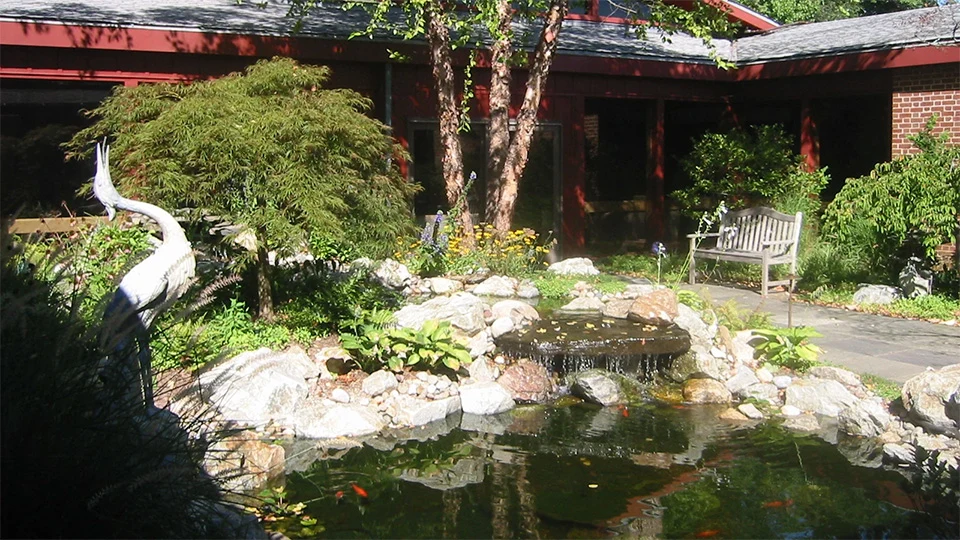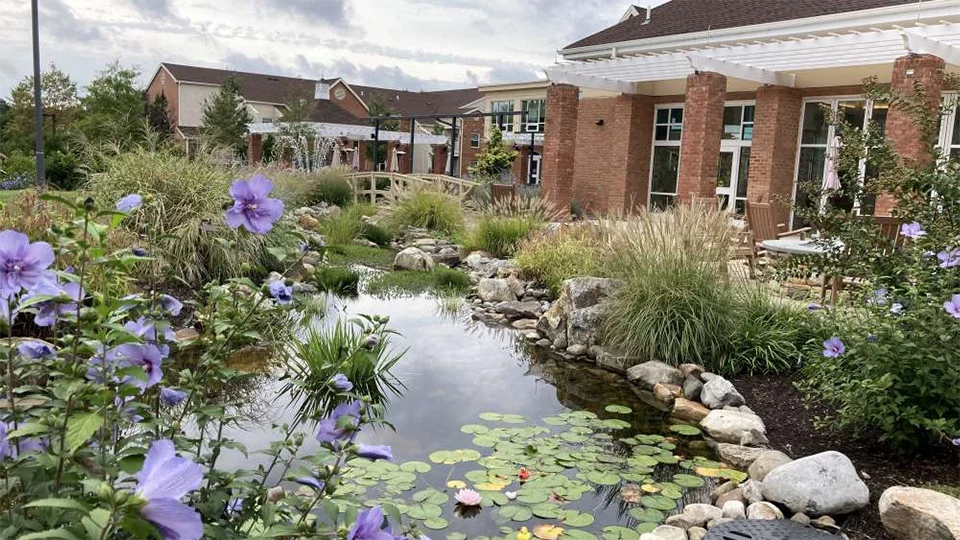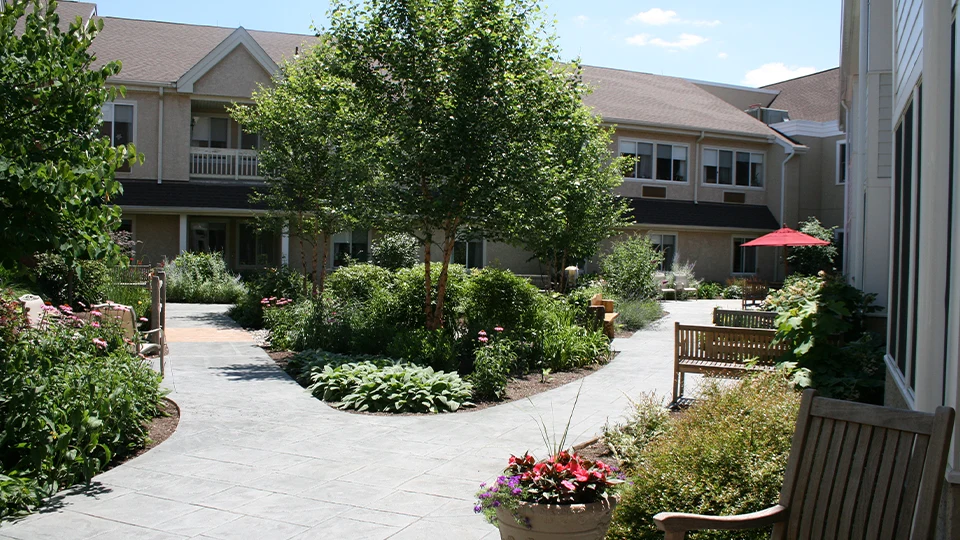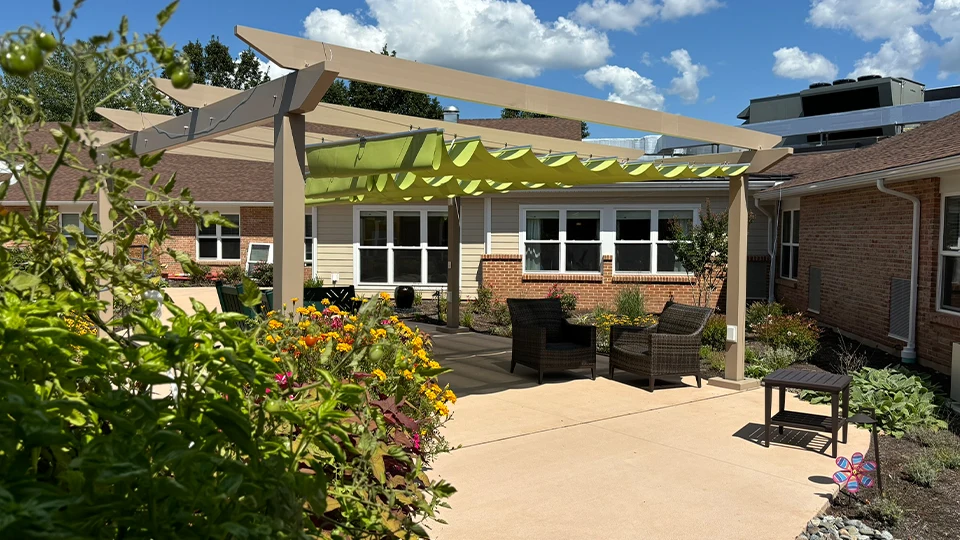Design Insights From an Expert In Therapeutic Gardens
 Imagine a place that can do the impossible – spark memories for the over six million Americans living with Alzheimer’s. These aren’t your typical gardens, they’re therapeutic gardens; carefully designed environments that offer stimulation and comfort to those who need it.
Imagine a place that can do the impossible – spark memories for the over six million Americans living with Alzheimer’s. These aren’t your typical gardens, they’re therapeutic gardens; carefully designed environments that offer stimulation and comfort to those who need it.
As a landscape architect with over twenty years of experience, Jack Carman is a leading expert in the growing field of therapeutic gardens. Specially designed for Alzheimer’s care, Jack understands the unique challenges and opportunities that designing these spaces can present. With his insights into the design process, the importance of stimuli and shade Jack is a wealth of knowledge for those looking to make an impact in designing architecture for the healthcare field.
Could you start by telling me a little bit about your professional experience? What drew you to landscape architecture, and more specifically, therapeutic gardens?
Sure, I’d be glad to. I’ve been a landscape architect since the early 1990s and have worked for various companies.
The last company I worked for was an engineering firm, and I did more planning than landscape architecture work. I wanted to do something a little bit more meaningful. My wife suggested I look at dementia gardens. She’s a gerontologist, so her work with older adults—she’s been doing that for maybe 30 years now—led me in this direction.
And it’s been an extremely rewarding outcome, if you will. In the late nineties, I started to look in the direction of doing work with seniors, senior communities, and more specifically people with memory impairments. So most of the work that I do is in the area of creating therapeutic gardens, not just in senior communities, but in other communities as well, hospitals, and working on a behavioral health garden in Sleepy Hollow, New York, as an example.
Would you be able to walk me through the design process itself from initial consultation to the finished product?
It varies from community to community. In new senior communities, you often work with administration and staff rather than family members, but their input is still crucial. In existing communities, family members sometimes volunteer and share details, like how their loved ones enjoyed birdwatching or roses, allowing those elements to be incorporated into the garden. Gathering as much information as possible helps tailor the space to the specific population it will serve.
The design intent may be active, with raised planters for horticultural activities or bird feeders as interactive elements. Incorporating such details leads to a better design, involving collaboration with stakeholders, refining plans, and creating construction drawings. The design can be for an independent garden or part of a larger project. During implementation, staying involved ensures that the design is completed as intended, even if adjustments like phasing certain features are necessary.
Following up after a few years is essential but can be challenging. Sometimes staff aren’t familiar with plant care, so providing lists of sensory plants helps staff and residents engage with the garden. Gardens should go beyond aesthetics, aiming to actively involve residents or patients, whether by encouraging them to find plants like lavender or simply enjoying the space through activities like picking flowers for arrangements.
Can you speak a bit more about the benefits?
There are different levels within the disease, but in general, we don’t live inside all the time. We enjoy being outside, and creating gardens gives people the opportunity to walk, which is one of the best forms of exercise. Being in the garden is calming, whether it’s listening to birds or the white noise from a water feature like a slow brook or fountain.
Natural sounds, like wind chimes – whether bamboo or metal – also have a calming effect. These combined elements help reduce stress and lower blood pressure, which are significant benefits. Gardens help keep us connected to the world around us, reinforcing our circadian rhythms and giving us that sense of connection to day and night.
Inside a residence or building, it can sometimes feel sterile, while outside, there’s so much more happening. In physical therapy gardens, therapists can do things that aren’t possible indoors, like using different types of pavement surfaces to help people transition back home. There are so many health benefits to getting people outside.
Trees are optimal for shade but take quite a while to grow, so built-in shade is an immediate solution. That being said, is there any evidence that suggests the dappled sunlight from shade panels, simulating that of a tree of a tree could be more beneficial than say the shade of a canopy?
Of course, I would assume that shade, in any fashion, allows the user to be outside longer, and that’s a benefit as well, yes?
It is important to be able to provide opportunities for shade within the garden. A shaded outdoor area is beneficial for older adults who may be less tolerant of changes in temperatures, sometimes commenting that it is too hot or too cold to go outside. A shaded area can provide cover from the sun, as well as precipitation.
When a garden is first constructed, the younger shade trees will not provide as much shade as more mature trees. That is why a combination of an overhead shade structure and shade trees provides options for the type of shade that is desired. The light under a shade tree may have a dappled or filtered effect, depending on the specific type of tree that is selected. More continuous shade can be found with Maple and Oak trees, as opposed to Honey Locust trees. A pergola or similar shade structure will provide complete coverage from the first days of the garden. And that allows the newly planted shade trees to increase their shade coverage as they mature.
Therefore, the design of the garden should balance the need for complete shade and placement of the trees where the need for complete shade may not be as great. For example, locating a pergola or similar overhead structure in close proximity to the building permits a person to enter the garden under a protected covering. And that may be as far as they want to venture out into the garden. Others may wish to walk in the garden, and shade trees placed along the sidewalks can provide more shade.
How do you typically implement shade into your gardens?
I think, in creating gardens it’s good to have a continuous shade area from the elements, so that it’s not just under a tree. Sometimes it could be a filtered light or a dappled light, right? So a little bit comes through and sometimes you see patterns on the ground and that can be disconcerting for someone with diminished visual acuity, they may not be able to walk as easily when it’s going from light to dark patterns and sometimes a tree can do that.
But if you have a continuous shade canopy, a shade structure, near a doorway, or over a patio area, it’s easier to maintain that complete shade under it. Also, if you start to get a light rain or a mist, you’re protected a little bit more under that than you would a living tree or a shade tree.
What are some of the differences when you’re designing a therapeutic garden when designing for a cognitive impairment as opposed to something like a physical disability or rehab?
When designing these gardens, you’re focusing on a specific population, need, or disease. A dementia garden, for example, will differ from a physical therapy or meditation garden. It should be a safe, enclosed area to prevent wandering and create a comfortable, pleasant space. One key element is shade, as older adults’ eyes can take five to eight minutes to adjust to outdoor light. A shade structure near the entrance helps with this transition from indoors to bright sunlight.
The shade should be located close to the entrance since some people may prefer sitting near the entry, observing the garden without venturing far. Comfortable tables and chairs should be provided, and if the garden is large enough, additional shade structures can be added throughout. The garden can serve as a destination for walks, with paths leading past flowers, benches, and small canopies where residents can rest under the shade.
In addition to constructing shade structures, incorporating shade trees is important. Other garden features like water elements, birdhouses, feeders, and birdbaths can enrich the environment. The design should also consider year-round interest, ensuring the garden is engaging and appealing throughout all four seasons.

Can you speak more about designing gardens for four-season interests? I’m sure it can be difficult to plan for the colder seasons.
People want to be able to go outside, so you want to design the garden so that it allows them to. It needs to have wide enough pathways so that people can wander through the garden. For pathways with hard surfaces, you’d want to use concrete or even tinted concrete.
It’s important to tone down the bright white nature of concrete itself, so adding color to it helps reduce glare. Making the garden comfortable for people visually will allow them to get outside, not just in the summertime, but in the winter too. But also are there benches around? Is it the right type of bench that’s designed for seniors, the seat height should be 18 inches and it should have a relatively flat seat to it. You don’t want to put Adirondack chairs out there because someone could get in an Adirondack chair and have a difficult time getting out of it.
Use furniture elements that are good throughout all the seasons and that are comfortable. Use pathways that are tinted and are an appropriate width. If you did need to shovel the snow you can easily clear the pathway off to allow someone to get outside. We’ve been using recycled rubber pathways that are a hundred percent porous, so they don’t freeze as easily in the winter time and it still allows people to be able to get outside, when the sun hits, it melts the snow and it just filters through the rubber surface and becomes a safe walking surface in the wintertime. Visibility is important too, so if someone is outside, they put a coat on. It’s December, and they’re walking in the garden, and the staff feels comfortable that they can see them. So having different parts of the garden visible from inside the residence is an important factor too.
Staff and caregivers have to feel comfortable that when someone is out in the garden, they’re safe, the staff can see them, they can find their way back in, and they don’t become disoriented.
Accessibility and Sustainability In The Garden
How does accessibility play a role in your design process?
The garden has to be 100% accessible.
There should be no steps, smooth, level pathways, minimal grade changes, or a 2% change in grade. You want to make sure that there are no edges and that the mulch is brought up to be even with the side of the walking path so there are no opportunities for tripping. Pathways should be five feet in width because that’s the design width that allows a person to pass with a wheelchair.
Walkways need to be wide enough, but they don’t have to be six feet like you might find in a park. So five feet is typically a good width for a garden path. And then a big factor are doors going in and out of the the garden so that there may be an automatic door that allows you to go out safely, especially if you are in a wheelchair and that there’s no step or anything getting out into the garden, it’s all one smooth level pathway out into the outdoor area.
It sounds like designing for accessibility presents some challenges, but there are some creative solutions.
The overall goal is just to make the garden as comfortable and safe as possible. Having benches spaced at certain intervals, if someone gets tired have them adjacent to or on the same material; if it’s a concrete walk then the bench is on a concrete pad directly adjacent to the walk so that you don’t have to step over anything. And we’ll come back to shade, in the summertime you mentioned the northeast, but especially in the south, it can be hot. So having some type of shade structure with maybe a mister system in it to help keep the temperatures down.
You can also decorate the garden. We talked about 12-season interest, but what about 24-hour interest, right? At night, you can have patio lights under a shade structure or pathway lights and low-voltage lights along the pathway.
If you’re sitting outside, just make it pleasant to look at in the evening. The garden should feel like your backyard, like you’re at home and sitting in your own yard. To be honest, a lot of these gardens are a lot better than my backyard. I’d be happy to sit in most of them.
Are there any other ways that you try to incorporate some sustainability practices into your gardens?
Some of the furniture that’s available is made of recycled plastic. It’s very durable, holds up well, and is easy to maintain. That’s a big part of the garden, too. The caregivers understand how to use the garden, but it’s got to be maintained properly.
So whether it’s an outside company coming in to maintain the plantings or the staff itself, maybe there’s a maintenance staff member tasked with general upkeep, such as sweeping the walks and removing branches.
It’s gotta be easy to maintain, but the two ways that I’ve been able to incorporate recycled materials are either in the pathways or the furniture itself.
Have you seen an increase in sustainability when designing, whether it’s a garden or any other landscape project?
Over the past 20 to 25 years, there has been a noticeable shift in the types of gardens being created, moving beyond healthcare settings and Alzheimer’s residences to include gardens for cancer patients, physical therapy, children’s hospitals, and even schools. Alongside this, sustainability has become a key focus, with practices like rain gardens and other environmentally sound methods being incorporated. There’s an ongoing debate about the use of native plant material, which requires balancing what was originally native to the area with what plants will be meaningful and familiar to those using the garden.
Selecting the right plants means considering both environmental factors and the emotional connection people have with certain plants. For example, while a rose bush may not be native to a region, it could bring comfort and familiarity to someone who loves roses. It’s essential to choose plants that resonate with the people who will experience the garden, rather than sticking strictly to what’s native. An example of this is a woman with Alzheimer’s who hadn’t spoken in weeks but was moved by a simple water feature, turning to say, “Isn’t that beautiful?” – demonstrating the profound connection people can have with familiar, soothing elements.
Ultimately, when deciding on native versus non-native plants, the focus should always come back to who the garden is being designed for. Whether it’s a balance of 50/50 or 60/40 in terms of plant selection, the goal is to create a space that fosters connection, peace, and comfort. The choice of plants and elements should enhance the garden’s ability to meet the emotional and physical needs of its users.

Looking Ahead, The Challenges and Opportunities in The Healthcare Industry
Are there currently any challenges you see your industry facing right now or in the future?
Challenges, I guess, in that I’m always looking for a wider acceptance and a realization of the importance of these gardens. I think we are getting there; people are realizing the benefits and I think society as a whole is coming to understand the importance of nature and why it’s so important for us to maintain our connection with nature so that these gardens or any gardens are accepted more. It sometimes becomes a fight or a challenge to get people to understand how important it is for any setting and for any environment and it’s not just creating a pretty garden, but I think it’s creating a garden that engages you and encourages you to participate in some aspect, whether that’s being outside in the garden, just sitting on a bench or maybe taking a walk in it, or maybe having a pair of binoculars and birdwatching.
They’re all different levels of engagement with nature, but I think the challenge is to get people to understand that “I’ll go down this road, turn off [my] device, and just focus on nature for a little while.” It’s a lot more calming, soothing, and beneficial.
Some may argue with me on that, but that’s my perspective, and I’m sticking to it.
You’ve talked a bit about acceptance, how common are therapeutic gardens now?
They’re becoming more and more common, which is a good thing. And I think what’s even better is they’re becoming expected. Reviewing agencies like the Joint Commission on Accreditation of Healthcare Organizations now mandates for new hospital construction that a patient has a view of nature from their hospital window.
Things like the Joint Commission help us create these gardens so that when they’re designing the overall community, whether it’s a hospital or a senior care facility, the gardens are not a second thought, but they’re incorporated from the beginning. So there’s a seamless transition from inside to outside. In older communities, the garden gets added on, and sometimes, it’s a circuitous route to try and find your way out to the garden.
But, more and more, the gardens are expected to be a part of the community, which is a good thing.
It’s safe to say that you believe adoption rates will continue to increase?
Yes. They are becoming more and more common as people ask for and expect them, you know? A good part, too, is that when someone has designed a new hospital, in magazines they promote their healing garden or senior community or physical therapy garden.
It helps sell a community and attract people, and it helps people make positive decisions, such as, ” Yeah, this is someplace I’d like to go to.” So, we’re not only expecting it but also seeing it developed.
Speaking of that, do you have a project that you are particularly proud of?
One of the more recent projects incorporated so many different garden types into one larger garden as a community in Northwest Pennsylvania, Meadowood. It’s in a senior care community, and the garden is designed for independent residents, so there is a part of the space off of their recreation room where they can come outside and do Tai Chi or other classes.
But then they also have an indoor pool with nano walls that open out into a patio with a fire pit. And then there’s a stream running along the area. So you have the sound of water and then you can use it for night with the fire pit and so forth. But then there’s also a component of it, they have an area for physical therapy.
Whether it’s the residents of the community or the people who are going there for short-term physical therapy, they can go outside and use the space because there are different walking surfaces and different activities that they can do out in the garden.
Then there’s a component of the garden too, another smaller garden area within the overall larger garden, that’s for people in assisted living. So the great part about this garden is that sometimes, in a lot of senior communities residents can be separated, the independent resident may not be assisted or with people with dementia, and so forth. But here in this garden, everyone engages in the garden together.
And there’s also an outdoor kitchen. So they’ll have concerts and culinary staff will be outside barbecuing and so forth. So it’s really the center of the community, so it’s really become all kinds of activities that happen right in the center of the community.
So it draws people together, in really positive and wonderful ways.

A Legacy of Therapeutic Design
Jack Carman is nationally recognized as an expert in the design of therapeutic gardens; as his decades of experience and expertise in landscape architecture show, his designs are as much about addressing specific cognitive needs as it is about creating inviting, healing spaces. From the strategic use of shade to sensory-rich pathways, every detail plays a role in fostering well-being. For those looking to make a meaningful impact through design, Jack’s insights offer valuable guidance on how to approach these unique environments with care and purpose.
